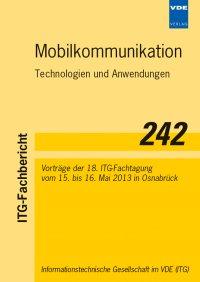Benefits of Topology Reconfiguration in Autonomous Wireless Backhaul Networks
Conference: Mobilkommunikation – Technologien und Anwendungen - 18. ITG-Fachtagung
05/15/2013 - 05/16/2013 at Osnabrück, Deutschland
Proceedings: Mobilkommunikation – Technologien und Anwendungen
Pages: 6Language: englishTyp: PDF
Personal VDE Members are entitled to a 10% discount on this title
Authors:
Mannweiler, Christian; Chakraborty, Pratip; Schotten, Hans (Wireless Communications and Navigation Group, University of Kaiserslautern, 67663 Kaiserslautern, Germany)
Abstract:
Coordinated wireless point-to-point networks constitute a reliable and cost-efficient technology for providing backhaul connectivity to access networks in remote or topologically challenging environments, e.g., mountainous regions like the Alps. Unlike mobile ad-hoc networks and conventional mesh networks, coordinated point-to-point backhaul networks share many of the characteristics of mobile communications systems while, at the same time, incurring significantly lower CAPEX and OPEX due to utilizing more cost-efficient hardware, e.g., IEEE 802.11 WLAN transceivers. Moreover, they are designed in a way as to account for energy-autonomous nodes (e.g., using solar panels for power supply), thus making parts of the network independent from the local power grid (if such a grid is available at all). However, one of the side effects is an increased risk of temporary unavailability of nodes. In this paper, we introduce a novel approach for optimizing the topology of such coordinated backhaul networks based on a range of relevant variables, among them total network capacity, current load in the access network, energy consumption of the considered topology, as well as battery level of nodes without continuous power supply. Further, we illustrate how such a reconfigurable backhaul topology can help delaying node failures or mitigating the adverse effects of temporary node failures. Furthermore, we quantitatively describe the impact of topology reconfiguration measures on performance metrics, among them total throughput and user outage. Besides these conventional network performance metrics, we use a novel lifetime extension measure to evaluate benefits with respect to energy efficiency.


